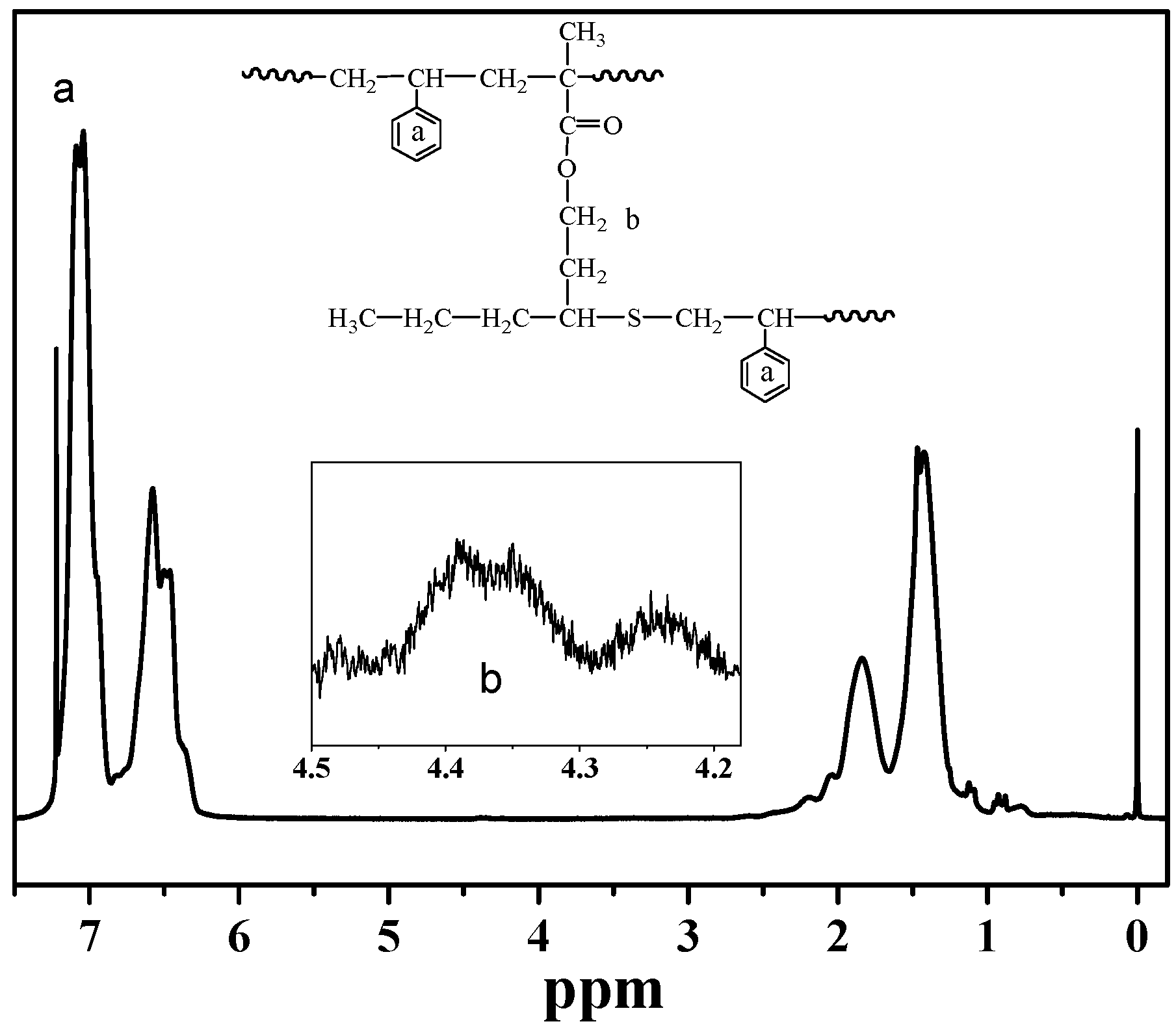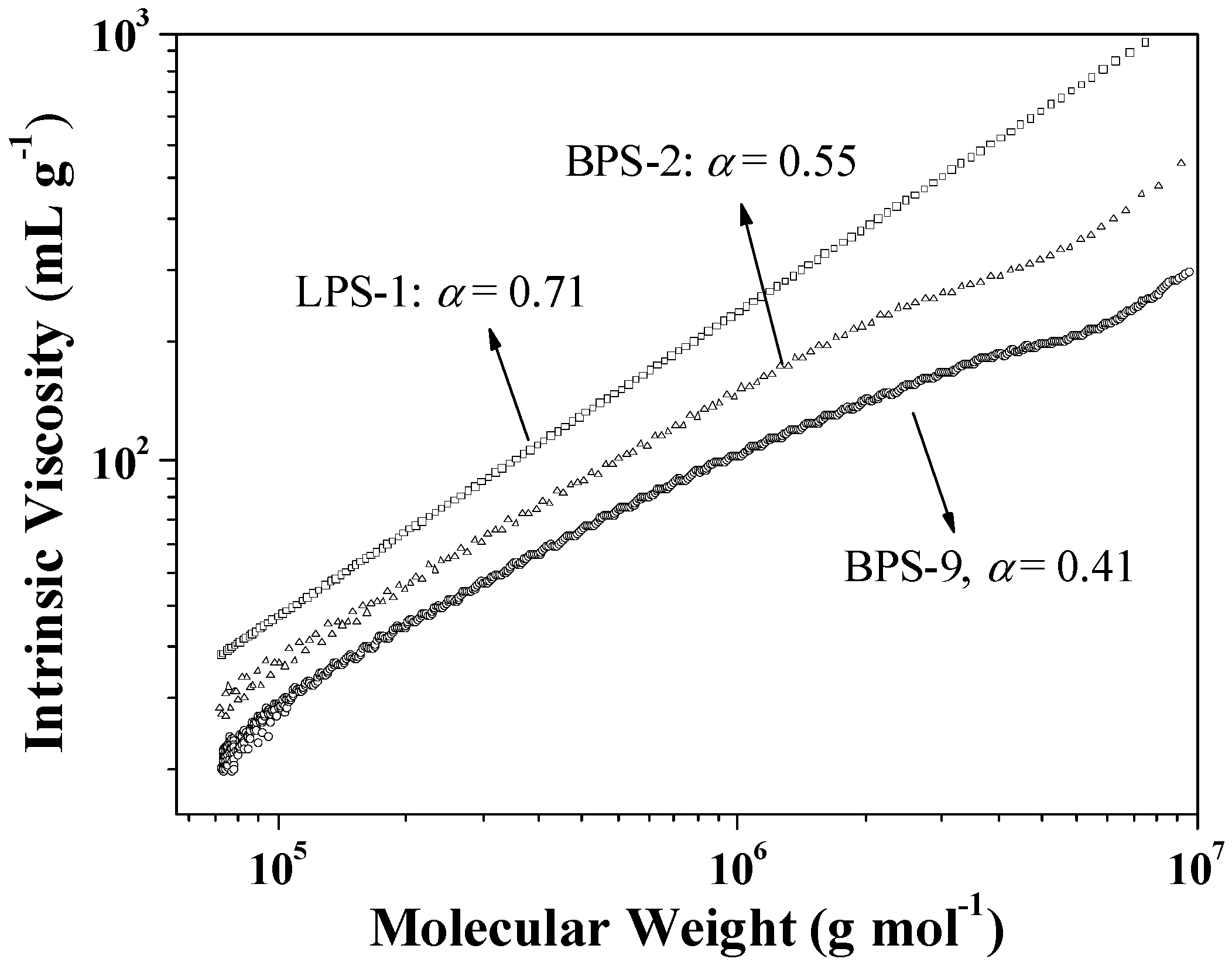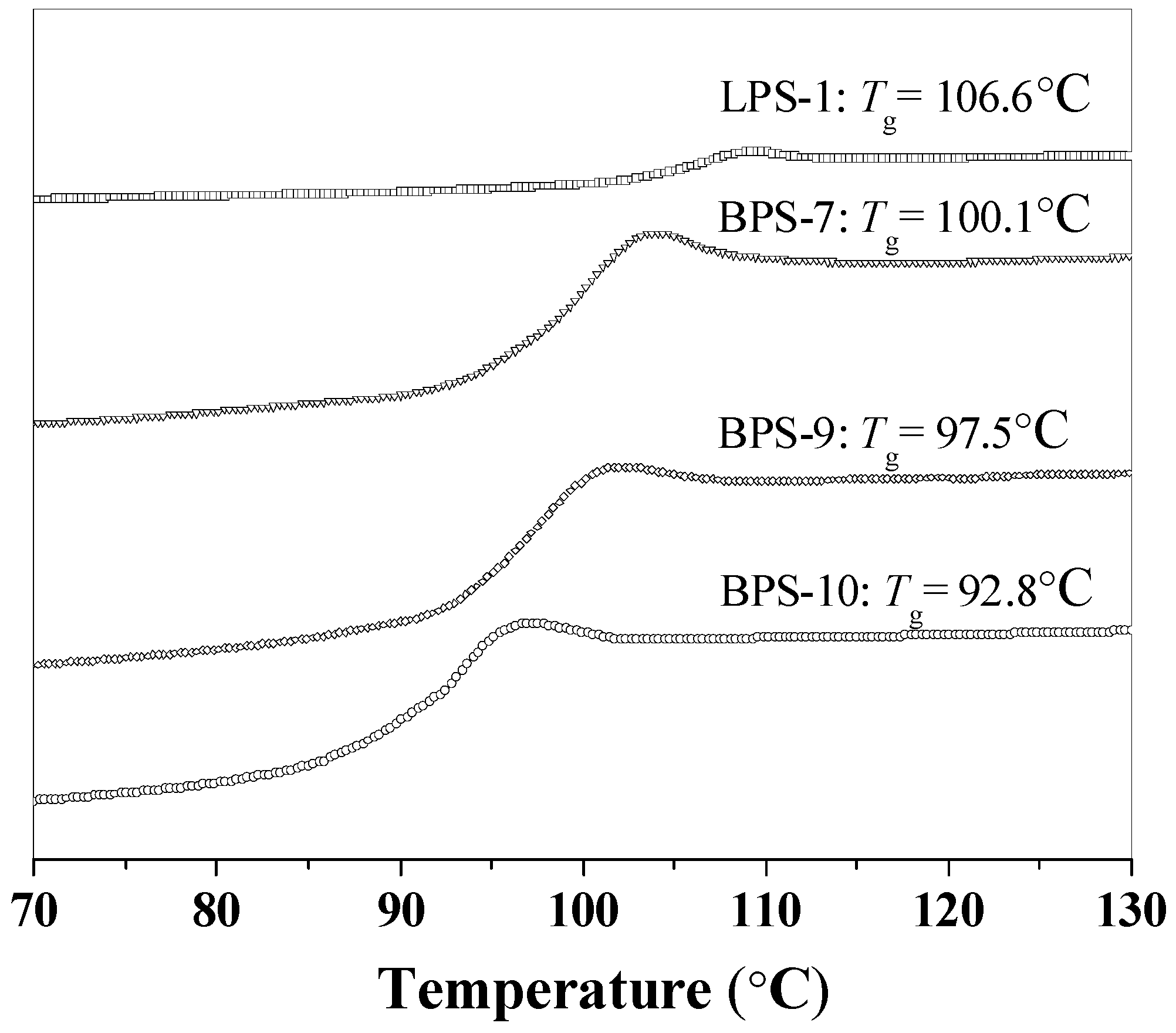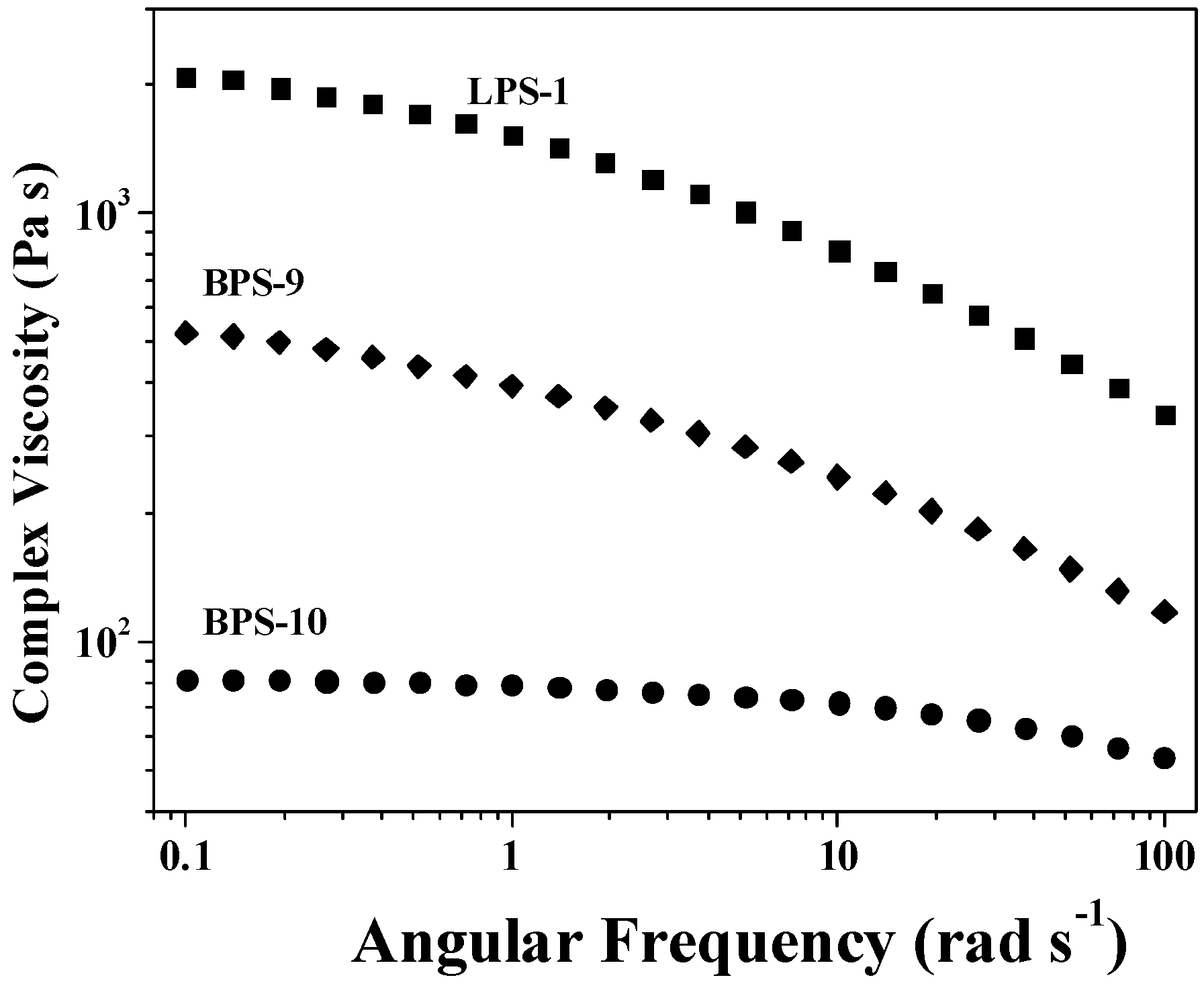Preparation and Properties of Branched Polystyrene through Radical Suspension Polymerization
Abstract
:1. Introduction
2. Experimental Section
2.1. Materials
2.2. Suspension Polymerization
2.3. Fourier Transform Infrared Spectroscopy
2.4. Proton Nuclear Magnetic Resonance Spectroscopy
2.5. Triple Detection Size Exclusion Chromatography (TD-SEC)
2.6. Differential Scanning Calorimetry (DSC)
2.7. Rheological Measurements
3. Results and Discussion
3.1. Preparation of Branched Polymers
3.2. Properties of the Branched Polymers
4. Conclusions
Supplementary Materials
Acknowledgments
Author Contributions
Conflicts of Interest
References
- Gao, C.; Yan, D. Hyperbranched Polymers: From Synthesis to Applications. Prog. Polym. Sci. 2004, 29, 183–275. [Google Scholar] [CrossRef]
- Konkolewicz, D.; Gray-Weale, A.; Perrier, S. The Structure of Randomly Branched Polymers Synthesized by Living Radical Methods. Polym. Chem. 2010, 1, 1067–1077. [Google Scholar] [CrossRef]
- Voit, B.I.; Lederer, A. Hyperbranched and Highly Branched Polymer Architectures—Synthetic Strategies and Major Characterization Aspects. Chem. Rev. 2009, 109, 5924–5973. [Google Scholar] [CrossRef] [PubMed]
- England, R.M.; Rimmer, S. Hyper/highly-branched Polymers by Radical Polymerisations. Polym. Chem. 2010, 1, 1533–1544. [Google Scholar] [CrossRef]
- Frechet, J.M.J.; Henmi, M.; Gitsov, I.; Aoshima, S.; Leduc, M.R.; Grubbs, R.B. Self-condensing Vinyl Polymerization: An Approach to Dendritic Materials. Science 1995, 269, 1080–1083. [Google Scholar] [CrossRef] [PubMed]
- Deng, G.; Chen, Y. A Novel Way To Synthesize Star Polymers in One Pot by ATRP of N-[2-(2-Bromoisobutyryloxy)ethyl]maleimide and Styrene. Macromolecules 2004, 37, 18–26. [Google Scholar] [CrossRef]
- Min, K.; Gao, H. New Method To Access Hyperbranched Polymers with Uniform Structure via One-Pot Polymerization of Inimer in Microemulsion. J. Am. Chem. Soc. 2012, 134, 15680–15683. [Google Scholar] [CrossRef] [PubMed]
- Georgi, U.; Erber, M.; Stadermann, J.; Abulikemu, M.; Komber, H.; Lederer, A.; Voit, B. New Approaches to Hyperbranched Poly(4-chloromethylstyrene) and Introduction of Various Functional End Groups by Polymer-analogous Reactions. J. Polym. Sci. Part A Polym. Chem. 2010, 48, 2224–2235. [Google Scholar] [CrossRef]
- Koh, M.L.; Konkolewicz, D.; Perrier, S. A Simple Route to Functional Highly Branched Structures: RAFT Homopolymerization of Divinylbenzene. Macromolecules 2011, 44, 2715–2724. [Google Scholar] [CrossRef]
- Wan, W.M.; Pan, C.Y. Direct Growth of Hyperbranched Polymers on Both Ends of a Linear Polymer. Macromolecules 2008, 41, 5085–5088. [Google Scholar] [CrossRef]
- Li, Y.; Ryan, A.J.; Armes, S.P. Synthesis of Well-Defined Branched Copolymers by Quaternization of Near-Monodisperse Homopolymers. Macromolecules 2008, 41, 5577–5581. [Google Scholar] [CrossRef]
- Xue, X.; Li, F.; Huang, W.; Yang, H.; Jiang, B.; Zheng, Y.; Zhang, D.; Fang, J.; Kong, L.; Zhai, G.; et al. Quadrangular Prism: A Unique Self-Assembly from Amphiphilic Hyperbranched PMA-b-PAA. Macromol. Rapid Commun. 2014, 35, 330–336. [Google Scholar] [CrossRef] [PubMed]
- Li, F.; Xue, X.; Huang, W.; Yang, H.; Jiang, B.; Zheng, Y.; Zhang, D.; Fang, J.; Chen, J.; Kong, L. Ultrafast Preparation of Branched Poly(methyl Acrylate) through Single Electron Transfer Living Radical Polymerization at Room Temperature. Polym. Eng. Sci. 2014, 54, 1579–1584. [Google Scholar] [CrossRef]
- Baskaran, D. Hyperbranched Polymers from Divinylbenzene and 1,3-Diisopropenylbenzene through Anionic Self-condensing Vinyl Polymerization. Polymer 2003, 44, 2213–2220. [Google Scholar] [CrossRef]
- Isaure, F.; Cormack, P.A.G.; Graham, S.; Sherrington, D.C.; Armes, S.P.; Butun, V. Synthesis of Branched Poly(methyl methacrylate)s via Controlled/living Polymerisations Exploiting Ethylene Glycol Dimethacrylate as Branching Agent. Chem. Commun. 2004, 1138–1139. [Google Scholar] [CrossRef] [PubMed]
- Zheng, Y.; Zhao, T.; Newland, B.; Poly, J.; Wang, W. Controlled Homopolymerization of Multi-vinyl Monomers: Dendritic Polymers Synthesized via An Optimized ATRA Reaction. Chem. Commun. 2013, 49, 10124–10126. [Google Scholar] [CrossRef] [PubMed]
- Zhao, T.; Zheng, Y.; Poly, J.; Wang, W. Controlled Multi-vinyl Monomer Homopolymerization through Vinyl Oligomer Combination as a Universal Approach to Hyperbranched Architectures. Nat. Commun. 2013, 4, 1873. [Google Scholar] [CrossRef] [PubMed]
- Rosselgong, J.; Armes, S.P.; Barton, W.R.S.; Price, D. Synthesis of Branched Methacrylic Copolymers: Comparison between RAFT and ATRP and Effect of Varying the Monomer Concentration. Macromolecules 2010, 43, 2145–2156. [Google Scholar] [CrossRef]
- Khan, A.; Malkoch, M.; Montague, M.F.; Hawker, C.J. Synthesis and Characterization of Hyperbranched Polymers with Increased Chemical Versatility for Imprint Lithographic Resists. J. Polym. Sci. Part A Polym. Chem. 2008, 46, 6238–6254. [Google Scholar] [CrossRef]
- Wang, W.; Zheng, Y.; Roberts, E.; Duxbury, C.J.; Ding, L.; Irvine, D.J.; Howdle, S.M. Controlling Chain Growth: A New Strategy to Hyperbranched Materials. Macromolecules 2007, 40, 7184–7194. [Google Scholar] [CrossRef]
- Wang, R.; Luo, Y.; Li, B.G.; Zhu, S. Modeling of Branching and Gelation in RAFT Copolymerization of Vinyl/Divinyl Systems. Macromolecules 2009, 42, 85–94. [Google Scholar] [CrossRef]
- Deng, G.; Cao, M.; Huang, J.; He, L.; Chen, Y. One-Pot Synthesis of Star Polymer by ATRP of Bismaleimide and an Excess of Styrene with a Conventional Initiator. Polymer 2005, 46, 5698–5701. [Google Scholar] [CrossRef]
- Bannister, I.; Billingham, N.C.; Armes, S.P.; Rannard, S.P.; Findlay, P. Development of Branching in Living Radical Copolymerization of Vinyl and Divinyl Monomers. Macromolecules 2006, 39, 7483–7492. [Google Scholar] [CrossRef]
- Gong, H.D.; Huang, W.Y.; Zhang, D.L.; Gong, F.H.; Liu, C.L.; Yang, Y.; Chen, J.H.; Jiang, B.B. Studies on the Development of Branching in ATRP of Styrene and Acrylonitrile in the Presence of Divinylbenzene. Polymer 2008, 49, 4101–4108. [Google Scholar]
- Yang, H.J.; Jiang, B.B.; Huang, W.Y.; Zhang, D.L.; Kong, L.Z.; Chen, J.H.; Liu, C.L.; Gong, F.H.; Yu, Q.; Yang, Y. Development of Branching in Atom Transfer Radical Copolymerization of Styrene with Triethylene Glycol Dimethacrylate. Macromolecules 2009, 42, 5976–5982. [Google Scholar] [CrossRef]
- Huang, W.; Yang, H.; Xue, X.; Jiang, B.; Chen, J.; Yang, Y.; Pu, H.; Liu, Y.; Zhang, D.; Kong, L.; et al. Polymerization Behaviors and Polymer Branching Structures in ATRP of Monovinyl and Divinyl Monomers. Polym. Chem. 2013, 4, 3204–3211. [Google Scholar] [CrossRef]
- Rosselgong, J.; Armes, S.P. Quantification of Intramolecular Cyclization in Branched Copolymers by 1H NMR Spectroscopy. Macromolecules 2012, 45, 2731–2737. [Google Scholar] [CrossRef]
- Xue, X.; Wang, Y.; Huang, W.; Yang, H.; Chen, J.; Fang, J.; Yang, Y.; Kong, L.; Jiang, B. New Insight into the ATRP of Monovinyl and Divinyl Monomers. Macromol. Chem. Phys. 2015, 216, 1555–1561. [Google Scholar] [CrossRef]
- Isaure, F.; Cormack, P.A.G.; Sherrington, D.C. Synthesis of Branched Poly(methyl methacrylate)s: Effect of the Branching Comonomer Structure. Macromolecules 2004, 37, 2096–2105. [Google Scholar] [CrossRef]
- Saunders, G.; Cormack, P.A.G.; Graham, S.; Sherrington, D.C. Use of Rapid Triple Detection Size Exclusion Chromatography to Evaluate the Evolution of Molar Mass and Branching Architecture during Free Radical Branching Copolymerization of Methyl Methacrylate and Ethylene Glycol Dimethacrylate. Macromolecules 2005, 38, 6418–6422. [Google Scholar] [CrossRef]
- Graham, S.; Cormack, P.A.G.; Sherrington, D.C. One-Pot Synthesis of Branched Poly(methacrylic acid)s and Suppression of the Rheological “Polyelectrolyte Effect”. Macromolecules 2005, 38, 86–90. [Google Scholar] [CrossRef]
- Baudry, R.; Sherrington, D.C. Synthesis of Highly Branched Poly(methyl methacrylate)s Using the “Strathclyde Methodology” in Aqueous Emulsion. Macromolecules 2006, 39, 1455–1460. [Google Scholar] [CrossRef]
- Costello, P.A.; Martin, I.K.; Slark, A.T.; Sherrington, D.C.; Titterton, A. Branched Methacrylate Copolymers from Multifunctional Monomers: Chemical Composition and Physical Architecture Distributions. Polymer 2002, 43, 245–254. [Google Scholar] [CrossRef]
- Chisholm, M.; Hudson, N.; Kirtley, N.; Vilela, F.; Sherrington, D.C. Application of the “Strathclyde Route” to Branched Vinyl Polymers in Suspension Polymerization: Architectural, Thermal, and Rheological Characterization of the Derived Branched Products. Macromolecules 2009, 42, 7745–7752. [Google Scholar] [CrossRef]
- Yamada, B.; Konosu, O.; Tanaka, K.; Oku, F. Preparation of Branched Polymer by Radical Polymerization Using Polymerizable Chain Transfer Agent. Polymer 2000, 41, 5625–5631. [Google Scholar] [CrossRef]
- Liu, J.; Wang, Y.; Fu, Q.; Zhu, X.; Shi, W. Branched Polymer via Free Radical Polymerization of Chain Transfer Monomer: A Theoretical and Experimental Investigation. J. Polym. Sci. Part A Polym. Chem. 2008, 46, 1449–1459. [Google Scholar] [CrossRef]
- Jiang, L.; Huang, W.; Xue, X.; Yang, H.; Jiang, B.; Zhang, D.; Fang, J.; Chen, J.; Yang, Y.; Zhai, G.; et al. Radical Polymerization in the Presence of Chain Transfer Monomer: An Approach to Branched Vinyl Polymers. Macromolecules 2012, 45, 4092–4100. [Google Scholar] [CrossRef]
- Huang, W.; Liu, C.; Yang, H.; Xue, X.; Jiang, B.; Zhang, D.; Kong, L.; Zhang, Y.; Komarneni, S. Facile Synthesis of Highly Branched Poly(acrylonitrile-co-vinyl acetate)s with Low Viscosity and High Thermal Stability via Radical Aqueous Solution Polymerization. Polym. Chem. 2014, 5, 3326–3334. [Google Scholar] [CrossRef]
- Jiang, Q.; Huang, W.; Yang, H.; Xue, X.; Jiang, B.; Zhang, D.; Fang, J.; Chen, J.; Yang, Y.; Zhai, G.; et al. Radical Emulsion Polymerization with Chain Transfer Monomer: An Approach to Branched Vinyl Polymers with High Molecular Weight and Relatively Narrow Polydispersity. Polym. Chem. 2014, 5, 1863–1873. [Google Scholar] [CrossRef]
- Burchard, W. Branched Polymers II; Roovers, J., Ed.; Springer: Berlin/Heidelberg, Germany, 1999; pp. 113–194. [Google Scholar]
- Burchard, W.; Schmidt, M.; Stockmayer, W.H. Information on Polydispersity and Branching from Combined Quasi-Elastic and Intergrated Scattering. Macromolecules 1980, 13, 1265–1272. [Google Scholar] [CrossRef]
- Yang, H.; Bai, T.; Xue, X.; Huang, W.; Chen, J.; Qian, X.; Zhang, G.; Jiang, B. A Versatile Strategy for Synthesis of Hyperbranched Polymers with Commercially Available Methacrylate Inimer. RSC Adv. 2015, 5, 60401–60408. [Google Scholar] [CrossRef]
- Luo, X.; Xie, S.; Liu, J.; Hu, H.; Jiang, J.; Huang, W.; Gao, H.; Zhou, D.; Lu, Z.; Yan, D. The Relationship between the Degree of Branching and Glass Transition Temperature of Branched Polyethylene: Experiment and Simulation. Polym. Chem. 2014, 5, 1305–1312. [Google Scholar] [CrossRef]







| Sample No. | Feed ratio | Mn.SEC a (g·mol−1) | Mw.MALLS b (g·mol−1) | PDI |
|---|---|---|---|---|
| LPS-1 | St100-AIBN0.5 | 50,700 | 191,400 | 3.53 |
| LPS-2 | St100-MHIB0.5-AIBN0.5 | 12,900 | 123,100 | 6.42 |
| BPS-1 | St100-MHM0.25-AIBN0.5 | 44,300 | 389,200 | 5.29 |
| BPS-2 | St100-MHM0.5-AIBN0.5 | 49,500 | 795,600 | 6.96 |
| BPS-3 | St100-MHM0.75-AIBN0.5 | gelation | ||
| BPS-4 | St100-MHM1.0-AIBN0.75 | gelation | ||
| BPS-5 | St100-MHM1.0-AIBN1.0 | 47,800 | 723,000 | 6.04 |
| BPS-6 | St100-MHM1.0-AIBN1.5 | 22,600 | 289,700 | 6.19 |
| BPS-7 | St100-MHM1.0-AIBN2.0 | 18,700 | 256,400 | 6.50 |
| BPS-8 | St100-MHM1.0-AIBN2.5 | 15,000 | 96,800 | 4.29 |
| BPS-9 | St100-MHM1.5-AIBN2.0 | 33,600 | 1,036,000 | 7.76 |
| BPS-10 | St100-MHM1.5-AIBN3.0 | 15,700 | 219,300 | 6.33 |
| BPS-11 | St100-MHM2.0-AIBN3.0 | 28,100 | 731,900 | 7.87 |
| BPS-12 c | St100-MHM2.0-AIBN0.5 | 32,900 | 985,400 | 10.26 |
| BPS-13 d | St100-MHM2.0-PPDS0.5 | 144,900 | 2,184,000 | 4.42 |
© 2017 by the authors. Licensee MDPI, Basel, Switzerland. This article is an open access article distributed under the terms and conditions of the Creative Commons Attribution (CC-BY) license ( http://creativecommons.org/licenses/by/4.0/).
Share and Cite
Huang, W.; Gu, W.; Yang, H.; Xue, X.; Jiang, B.; Zhang, D.; Fang, J.; Chen, J.; Yang, Y.; Guo, J. Preparation and Properties of Branched Polystyrene through Radical Suspension Polymerization. Polymers 2017, 9, 14. https://doi.org/10.3390/polym9010014
Huang W, Gu W, Yang H, Xue X, Jiang B, Zhang D, Fang J, Chen J, Yang Y, Guo J. Preparation and Properties of Branched Polystyrene through Radical Suspension Polymerization. Polymers. 2017; 9(1):14. https://doi.org/10.3390/polym9010014
Chicago/Turabian StyleHuang, Wenyan, Weikai Gu, Hongjun Yang, Xiaoqiang Xue, Bibiao Jiang, Dongliang Zhang, Jianbo Fang, Jianhai Chen, Yang Yang, and Jinlong Guo. 2017. "Preparation and Properties of Branched Polystyrene through Radical Suspension Polymerization" Polymers 9, no. 1: 14. https://doi.org/10.3390/polym9010014
APA StyleHuang, W., Gu, W., Yang, H., Xue, X., Jiang, B., Zhang, D., Fang, J., Chen, J., Yang, Y., & Guo, J. (2017). Preparation and Properties of Branched Polystyrene through Radical Suspension Polymerization. Polymers, 9(1), 14. https://doi.org/10.3390/polym9010014






